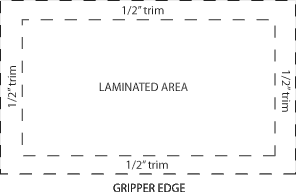 |
Henschel Coating & Laminating 15805 W. Overland Dr. New Berlin, Wisconsin 53151 Ph: (262) 786-1750 |
|
|
LAMINATION
Properties
Lamination delivers maximum attraction at the point of sale and maximum protection from general handling, grease, dirt, water, weather and time. A good standard of finish can be obtained on almost all types of paper and board. Gloss Polypropylene (OPP) – Orientated polypropylene offers high gloss, tear resistance, acid resistance and flexing strength. Less expensive than other types of film, OPP is ideal where the specific properties available in other films are not required. This lamination is commonly used for dust jackets, calendars and write-on/wipe-off applications. (Special adhesives are necessary if gluing is required.) Matte Polypropylene (Matte OPP) - Provides a soft, smooth finish that is perfect for dust jackets and presentation folders. This lamination is often used in combination with Gloss Spot UV. This lamination has a very flat/dull, non-reflective soft finish and can scuff. Gloss Polyester (PET) – Provides excellent abrasion resistance, scuff resistance, strength and durability, and extra heat resistance. This lamination is often used for case-bound books, binders, box wraps, and menus. Glueable/Stampable Gloss Polyester (AGX) - To promote easier gluing and foil stamping on top of the lamination. Used for cartons, folders, case-bound books, binders, box wraps and anything else that would require gluing or stamping. Matte Polyester (Matte PET) - Offers the same protective qualities as Gloss PET but provides a highly scuff-resistant matte surface, which is excellent for high use products. This lamination has more of a semi-gloss appearance and also can be used in combination with a Spot Gloss UV. Gloss Lay-Flat – Designed specifically to negate the effect of curl caused by moisture absorbed into the paper stock after laminating. This glossy film is very scuff resistant and durable. Lay-Flat is being used for book covers, magazines, posters, box wraps, folders and any other product where flatness is critical. Matte Lay-Flat - Designed specifically to negate the effect of curl caused by moisture absorbed into the paper stock after laminating. This lamination is also very durable but has a flat/dull, non-reflective finish on top of the film, which can scuff. This product is excellent in combination with Spot Gloss UV. Lamination Thickness' Available - The standard thickness of lamination that we use is approximately 1.2 - 1.3 mils added per side laminated. The lamination is .5 - .6 mils and the adhesive is .7 mils. Laminations are also available in 1.7, 3, 5 and 10 mil versions. 3, 5 and 10 mil laminations must be applied to both sides of the stock to avoid curl and are available in just gloss and matte polyester. Due to the 3, 5 and 10 mil needing to be applied both sides at a time; both gripper and side guide edges can not be kept completely clean. Either the gripper or the side guide will be kept clean depending on the way the sheets have to run through the machine. Sheet-fed Laminations - Maximum sheet size: 50” x 52” or 40” x 55” Minimum sheet size: 8 ½” x 11” Maximum laminated width: 49” x 51” or 39" x 54” Minimum weight: 70lb Maximum thickness: 24 pt Clean-Edge Allowances – Because we laminate from rolls of film (to which adhesive is applied or thermal adhesive are activated), it is always necessary for the film to run off one edge of the printed sheet. Three edges of the sheet will be free of lamination, two of these edges will be the printer’s gripper and side guide. (Which will be clean for any subsequent bindery operations) Sheets have to be overlapped prior to laminating which results in a slight indentation along the overlap line. This overlap line must be outside of the final trimmed size. Due to the 3, 5 and 10 mil needing to be applied both sides at a time; both gripper and side guide edges can not be kept completely clean. Either the gripper or the side guide will be kept clean depending on the way the sheets have to run through the machine.  Paper and Board – Most kinds and caliper of paper and board from 70lb to 24pt. can be laminated provided that they are supplied flat, free from creases or distortion and at a moisture content which is stable in the expected environment (50-55% R.H.). Skids must be shrink-wrapped and have skid tops. Spray Powder – An excess of anti-offset spray powder in any area of the printed sheet will be highlighted by the lamination. To ensure the best results, use the minimum possible amount of the fine grain spray powder and ensure that it is evenly applied. Do not use encapsulated spray powders. Inks – Ink manufactures now offer specially formulated inks and press varnishes for lamination. These should always be used and should have the following characteristics:
Digital Printed Sheets - Each job should be tested prior to full print production to check for ink compatibility with the lamination. Testing is recommended where exact color matching is required as lamination may change the optical qualities of a color. Note: Drawdowns are not representative of production run samples. |